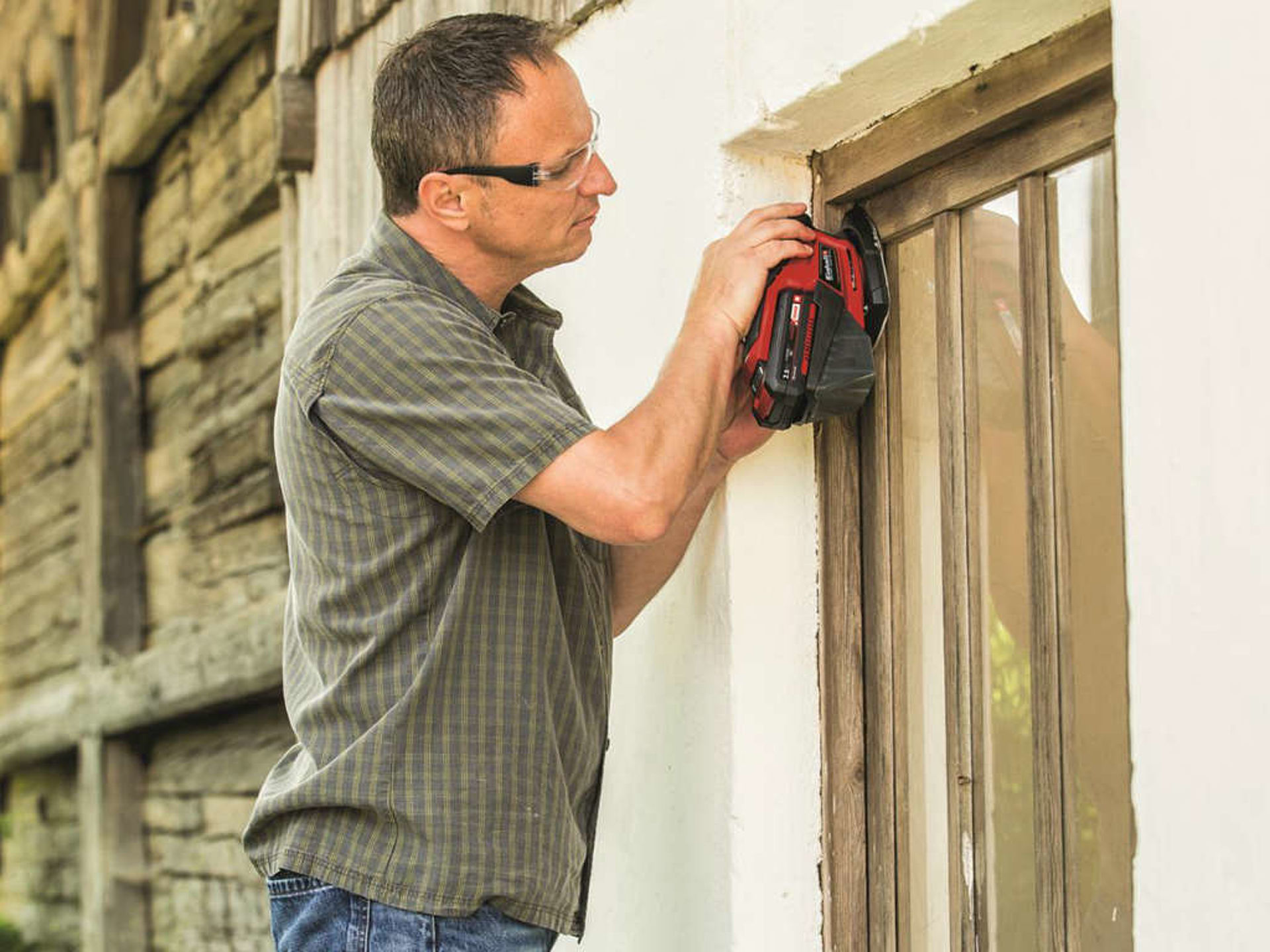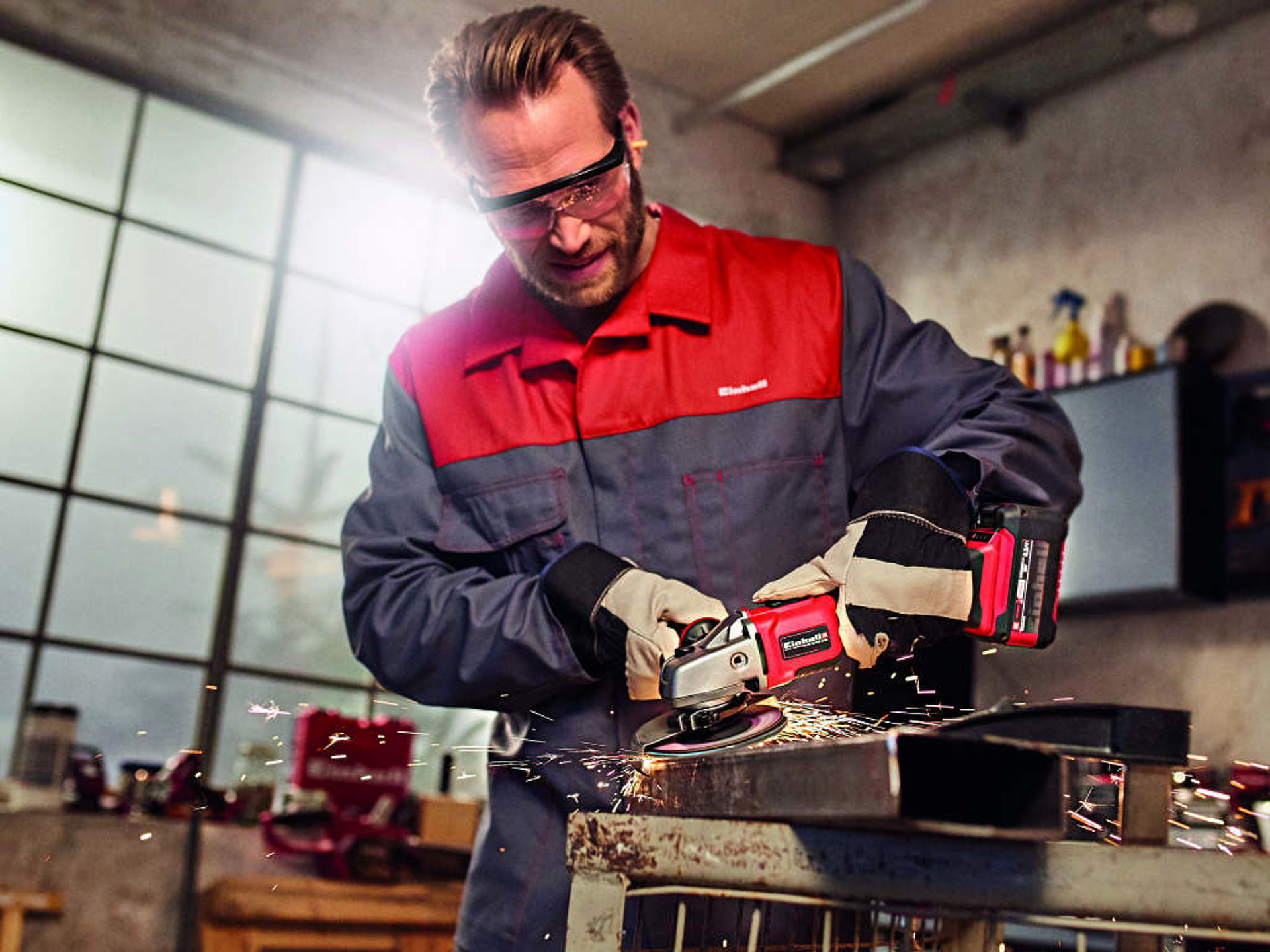Which grinder for which use?
Finding the right grinder for your own projects is often not as easy as you think. The variety of different grinders makes it difficult for many to make decisions. Drywall sander, orbital sander, or rather an rotating sander? With this article we will give you the background knowledge you need and answer the most frequently asked questions so that you can finally find the right grinder for your wood, metal or renovation work.
The Drywall Polisher
The drywall sander, also called ceiling sander or wall sander, is – as its name says – used for sanding troweled drywalls, ceilings and interior walls. It removes wallpaper remnants, adhesive residues, paints, varnishes and loose plaster, to prepare the surface for further processing such as e. g. painting or wallpapering. With its rotating disc and sandpaper in suitable grain size, it is preferably used for processing plasterboard, filler and wood.
For use on ceilings or high walls, it is advisable to pay attention to a telescopic handle and a joint bearing on the grinding head of the drywall sander. Thanks to the flexible length and the increased mobility of the grinding head, the surfaces to be machined can also be reached without a ladder or scaffolding, which saves time and increases occupational safety. Many wall sanders, both drywall sanders and concrete sanders, have a removable edge or the ability to fold up part of the dust cover, allowing you to sand down to the edge of the work surface.
So you don’t have to remove the sanding dust after grinding with the vacuum cleaner and there’s also no dust development while working, it is convenient to use the drywall sander with integrated suction system. In combination with a wet and dry vacuum cleaner, the workplace remains clean.

The Concrete Grinder
The concrete grinder can work with its rotating disk large concrete walls, ceilings and floors. It grinds and smooths bumps such as Paint layers, tile adhesives or carpet adhesives. The difference between concrete grinder and drywall sander: Compared to the drywall sander, the concrete grinder can be used for grinding and cleaning of hard materials such as screed, concrete or granite thanks to its higher performance and attachments such as diamond grinding plates or steel brushes. The drywall sander, on the other hand, is used to sand softer materials such as plasterboard and putty. The concrete grinder is similar in construction to the angle grinder, so it can be easily differenced from the drywall sander, which usually has a telescopic handle.
The Orbital Sander
The rectangular grinding plate of the orbital sander moves in circular oscillatory movements over the surface. It is best suited for surface grinding and, in addition to the processing of wood surfaces, it can also remove layers of paint or varnish. The orbital sander is ideal for large and smooth surfaces, but also for corners, edges and curves. For example, for grinding a paint‐coated wooden table. While working with the tool, you should be careful to run the orbital sander slightly obliquely or in a circular motion to create a uniform sanding pattern.

The Rotating Sander
In contrast to the orbital sander, which exerts only oscillating movements, additional abrasion is generated by the rotation of the grinding disc. The rotating sander is used for grinding medium and large surfaces. Due to the eccentric grinding movements, the sanding pattern is particularly even. Even curved surfaces can be evenly removed with a padded sanding pad, by working in rotating movements. The material abrasion is very high with this grinder, so it is ideal for sanding paints and varnishes and for preparing paint work. It should be noted, however, that the eccentric grinder must first be placed on the workpiece before turning it on. Otherwise, it can lead to unsightly grooves in the surface. With suitable attachments, the orbital sander can also be used for other jobs: with a polishing hood, for example, the device can also be used for polishing.

The Belt Sander
Instead of a sanding sheet, the belt sander has an endless sanding belt. The belt sander is therefore suitable for large to very large areas, as it has a high removal rate. Its endless sanding belt can be used for wood, plastic and metals. And is also used for removing paint or varnish layers. Precise grinding with the belt sander, however, requires a lot of practice, since due to the design grooves can easily be formed during grinding. Beginners should therefore use the belt grinder rather for coarser work.

The Multi-Sander
The multi-sander is the all-rounder among grinders. Thanks to its iron-shaped grinding plate, it can be used flexibly. It is used for working on small and medium-sized areas. His specialty, however, is the grinding of small, hard-to-reach surfaces: With its tapered grinding surface, it is ideally suited for fine grinding of folds, corners and edges. The multi-sander can be used for wood, metal, paint or painted surfaces. With the right choice of sanding sheets, both the sanding, smoothing or polishing with the multi-sander is possible.

The Delta Sander
The delta sander does not differ significantly in its field of application from the multi-sander. Its triangular sanding sheet is even smaller than the multi-sander, making it the perfect solution to facilitate machining even in very small, angular corners and at edges. The ergonomic design and the grip, which is often equipped with a softgrip, also allows one-handed guidance of the device. The type of abrasive sheets depends on the material of the surface to be ground.

The Angle Grinder
Depending on the disc used, the angle grinder can perform parting, grinding and roughing operations on a wide variety of materials. Thanks to the large number of discs and attachments, many craftsmen and DIY enthusiasts have the opinion that the angle grinder can even replace other tools. When working with the angle grinder, however, it is very important to never work with the wrong disc! For example, roughing with a cutting disc can result in serious injury. Here is a brief overview of the fields of application of the various discs for the angle grinder:

Which disc to use for the angle grinder?
Cutting discs: The cutting disc is, as the name implies, used for cutting. They are available in different materials, diameters and thicknesses. It is important to pay attention to the specified disc diameter of the angle grinder. The wheel diameters 115, 125 mm and 230 mm form the standard sizes. Depending on the selected cutting disc, the angle grinder can cover a wide range of application areas. For example, there are different cutting discs for cutting tiles than for cutting granite, for metal there are also other discs than for stainless steel, etc. Only wood and plastics can be better separated with appropriate saws due to the high temperatures that occurs when using the angle grinder. Due to the thin construction of the discs, they are ONLY suitable for cutting work. If you were to grind with them, the danger would be great that they burst and injure the user with the flying parts. In addition, care should be taken during polishing and sharpening metals, to not use a 230mm or larger cutting disc. Otherwise, the force of the angle grinder could damage the surface of the workpiece.
Roughing disc: With the help of the roughing disc, the user can roughly rough workpieces. Since roughing discs are usually much thicker / wider than cutting discs (about half a centimeter), they are conceivably unsuitable for cutting work. Thanks to their stability, they are ideal for reducing bumps and roughening surfaces.
Grinding disc: When using grinding discs, it is important to make sure that they are made of the right material. Abrasive wheels made of fine corundum are taken for example rather for metal grinding (removal of rust). On the other hand, diamond grinding discs are ideal for working with stone, concrete, ceramics or tiles.
Which abrasive sheet for which application?
Basically, with abrasives: the smaller the number that is on the back of the abrasive, the coarser the grit and the more abrasion is achieved when grinding. The larger the grain size, the finer the sanding pattern and the smaller the abrasion. As a rule, you begin the grinding with a bigger grain size and then gradually change step by step to finer sizes. Here is a short overview:
| Grit | Sanding | Examples |
|---|---|---|
| 6-30 | Very coarse | Removing paint layers |
| 40–80 | Coarse | Rough pre-grinding and shaping the wood |
| 100–200 | Fine | Fine sanding for wood surfaces |
| 220–1000 | Very fine | Re-grinding of painted surfaces |
| 1000+ | Extremely fine | Polishing of e.g. resin |










